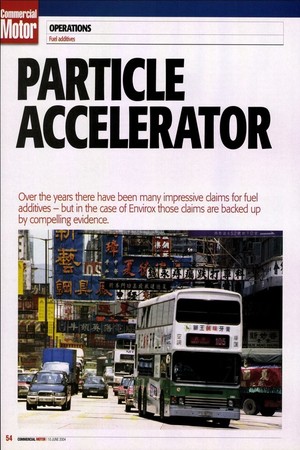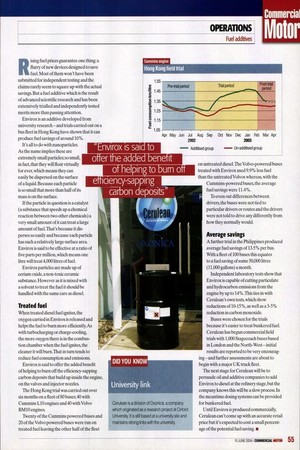PARTICLE
Page 48

Page 49

If you've noticed an error in this article please click here to report it so we can fix it.
ACCELERATOR
Over the years there have been many impressive claims for fuel additives — but in the case of Envirox those claims are backed up
by compelling evidence.
Rising fuel prices guarantee one thing: a flurry of new devices designed to save fuel. Most of them won't have been submitted for independent testing and the claims rarely seem to square up with the actual savings. But a fuel additive which is the result of advanced scientific research and has been extensively trialled and independently tested merits more than passing attention.
Rising fuel prices guarantee one thing: a flurry of new devices designed to save fuel. Most of them won't have been submitted for independent testing and the claims rarely seem to square up with the actual savings. But a fuel additive which is the result of advanced scientific research and has been extensively trialled and independently tested merits more than passing attention.
Rising fuel prices guarantee one thing: a flurry of new devices designed to save fuel. Most of them won't have been submitted for independent testing and the claims rarely seem to square up with the actual savings. But a fuel additive which is the result of advanced scientific research and has been extensively trialled and independently tested merits more than passing attention.
Envirox is an additive developed from university research — and trials carried out on a bus fleet in Hong Kong have shown that it can produce fuel savings of around 10%.
Envirox is an additive developed from university research — and trials carried out on a bus fleet in Hong Kong have shown that it can produce fuel savings of around 10%.
It's all to do with nanoparticles. As the name implies these are
extremely small particles; so small, iir, in fact, that they will float virtually for ever, which means they can easily be dispersed on the surface of a liquid. Because each particle is so small that more than half of its mass is on the surface.
extremely small particles; so small, iir, in fact, that they will float virtually for ever, which means they can easily be dispersed on the surface of a liquid. Because each particle is so small that more than half of its mass is on the surface.
extremely small particles; so small, iir, in fact, that they will float virtually for ever, which means they can easily be dispersed on the surface of a liquid. Because each particle is so small that more than half of its mass is on the surface.
extremely small particles; so small, iir, in fact, that they will float virtually for ever, which means they can easily be dispersed on the surface of a liquid. Because each particle is so small that more than half of its mass is on the surface.
If the particle in question is a catalyst (a substance that speeds up a chemical reaction between two other chemicals) a very small amount of it can treat a large amount of fuel.That's because it disperses so easily and because each particle has such a relatively large surface area. Envirox is said to be effective at a ratio of five parts per million, which means one litre will treat 4,000 litres of fuel.
Envirox particles are made up of cerium oxide, a non-toxic ceramic substance. However as it is mixed with a solvent to treat the fuel it should be handled with the same care as diesel.
Treated fuel
When treated diesel fuel ignites, the oxygen carried in Envirox is released and helps the fuel to burn more efficiently. As with turbocharging or charge-cooling, the more oxygen there is in the combustion chamber when the fuel ignites, the cleaner it will burn.That in turn tends to reduce fuel consumption and emissions.
When treated diesel fuel ignites, the oxygen carried in Envirox is released and helps the fuel to burn more efficiently. As with turbocharging or charge-cooling, the more oxygen there is in the combustion chamber when the fuel ignites, the cleaner it will burn.That in turn tends to reduce fuel consumption and emissions.
Envirox is said to offer the added benefit of helping to burn off the efficiency-sapping carbon deposits that build up inside the engine, on the valves and injector nozzles.
The Hong Kong trial was carried out over six months on a fleet of 80 buses; 40 with Cummins L10 engines and 40 with Volvo BM10 engines. Twenty of the Cummins powered buses and 20 of the Volvo powered buses were run on treated fuel leaving the other half of the fleet
on untreated diesel.The Volvo-powered buses treated with Envirox used 9.9% less fuel than the untreated Volvos whereas, with the Cummins-powered buses, the average fuel savings were 11.4%.
on untreated diesel.The Volvo-powered buses treated with Envirox used 9.9% less fuel than the untreated Volvos whereas, with the Cummins-powered buses, the average fuel savings were 11.4%.
To even out differences between drivers, the buses were not tied to particular drivers or routes and the drivers were not told to drive any differently from how they normally would.
Average savings
A further trial in the Philippines produced average fuel savings of 13.5% per bus. With a fleet of 100 buses this equates to a fuel saving of some 50,000 litres (11,000 gallons) a month.
Independent laboratory tests show that Envirox is capable of cutting particulate and hydrocarbon emissions from the engine by up to 14% .This ties in with Cerulean's own tests, which show reductions of 10-15%, as well as a 3-5% reduction in carbon monoxide.
Buses were chosen for the trials because it's easier to treat bunkered fuel. Cerulean has begun commercial field trials with 1,000 Stagecoach buses based in London and the North-West — initial results are reported to be very encouraging — and further assessments are about to begin with a major UK truck fleet.
Buses were chosen for the trials because it's easier to treat bunkered fuel. Cerulean has begun commercial field trials with 1,000 Stagecoach buses based in London and the North-West — initial results are reported to be very encouraging — and further assessments are about to begin with a major UK truck fleet.
The next stage for Cerulean will be to persuade oil and additive companies to add Envirox to diesel at the refinery stage, but the company knows this will be a slow process. In the meantime dosing systems can be provided for bunkered fuel. Until Envirox is produced commercially, Cerulean can't come up with an accurate retail price but it's expected to cost a small percentage of the potential fuel saving. •
























































































































































































